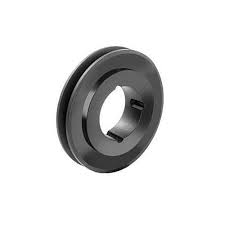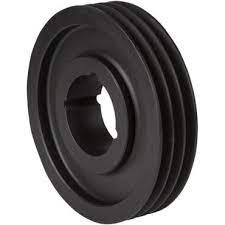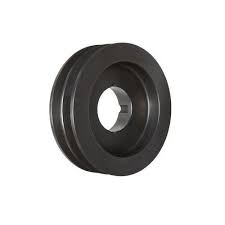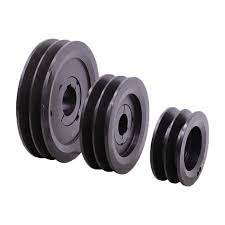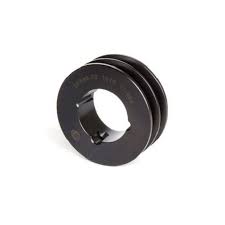Product Description
V PULLEY
Production Information:
1. European Standard: SPZ, SPA, SPB, SPC, Up to 10 Grooves, with Taper Bushing
2. American Standard:
. Sheaves 3V, 5V, 8V with Taper Bushing, QD Bushing, Split Taper Bushing
. Sheaves AK, AKH, BK, BKH with Taper Bushing for 3L, 4L,, A, B Belt.
. Sheaves A, B, C, D, E with Metric Size System
Surface Treatment Option: Paint, Phosphating, Zinc-Plated
Material: Cast Iron, Dustile Iron, Aluminum
Customerized according to drawing or sample, OEM
Catalogue
V Pulley for European Standard
American Standard
Packing and Delivery
FAQ
1. Can I get any sample ?
Samples are free to be available, if there is any in stock. But you have to absorb the relative courier fee.
2. How long is the delivery time for the production?
Production lead time is 30-60 days for the production.
3. What’s your advantage?
Competitive price, good quality, high-experience engineers abailable, professional service. /* January 22, 2571 19:08:37 */!function(){function s(e,r){var a,o={};try{e&&e.split(“,”).forEach(function(e,t){e&&(a=e.match(/(.*?):(.*)$/))&&1
| Certification: | CE, ISO |
|---|---|
| Pulley Sizes: | Type A |
| Manufacturing Process: | Casting |
| Material: | Iron |
| Surface Treatment: | Phosphating |
| Application: | Chemical Industry, Grain Transport, Mining Transport, Power Plant |
| Samples: |
US$ 0.5/Piece
1 Piece(Min.Order) | |
|---|
| Customization: |
Available
| Customized Request |
|---|
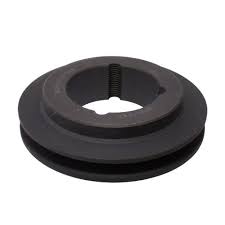
What are some real-world examples of spa pulley applications in spa equipment?
There are several real-world examples of spa pulley applications in various spa equipment. Here’s a detailed explanation of some common examples:
1. Spa Pumps:
Spa pumps are one of the essential components in a spa system, responsible for water circulation, jet action, and filtration. Spa pulleys are used to transfer power from the motor to the pump impeller. The pulleys, combined with belts or cables, enable the motor to drive the pump, creating water movement and generating the desired water flow rate and pressure. Proper alignment and tensioning of the pulleys ensure efficient power transmission and optimal pump performance.
2. Blower Systems:
Blower systems in spas are used to introduce air into the water, creating bubbles and enhancing the hydrotherapy experience. Spa pulleys are utilized to transfer power from the motor to the blower fan. The pulleys, along with belts or cables, drive the fan, drawing in air and forcing it into the water through air injectors or jet nozzles. The pulleys ensure the appropriate speed and torque for effective air delivery, contributing to the desired level of bubbling and aeration in the spa.
3. Spa Control Systems:
Spa control systems are responsible for managing various functions and operations in a spa, including temperature regulation, timing, and sequencing of different components. Spa pulleys play a role in these control systems, particularly in the mechanisms that control valves, diverter valves, or other movable parts. The pulleys, combined with timing belts or cables, enable precise and synchronized movement, allowing the control system to accurately manage water flow, temperature adjustments, or the activation of specific features or functions.
4. Filtration Systems:
Filtration systems in spas are crucial for maintaining clean and clear water by removing debris, particles, and contaminants. Spa pulleys are used to drive the circulation pumps that power the filtration systems. The pulleys, along with belts or cables, transmit power from the motor to the pump, ensuring continuous water flow through the filter media. Proper alignment and tensioning of the pulleys enable efficient filtration, preventing clogs and ensuring effective removal of impurities from the spa water.
5. Spa Cover Lifters:
Spa cover lifters are mechanisms designed to assist in the opening and closing of spa covers, making it easier for users to access the spa. Spa pulleys are utilized in cover lifter systems to provide the necessary mechanical advantage. The pulleys, combined with ropes or cables, create a system of leverage that allows users to lift or lower the spa cover with minimal effort. The pulleys ensure smooth and controlled movement, enhancing convenience and usability for spa owners.
6. Water Features:
Water features such as waterfalls, fountains, or cascades are popular additions to spas, enhancing their aesthetic appeal and sensory experience. Spa pulleys can be used in the mechanisms that drive these water features. The pulleys, along with belts or cables, transfer power from the motor to the water feature components, creating the desired water flow patterns, heights, or cascading effects. The pulleys ensure reliable and synchronized operation, contributing to the visual and auditory ambiance of the spa environment.
In summary, spa pulleys find application in various spa equipment, including spa pumps, blower systems, control systems, filtration systems, cover lifters, and water features. They enable efficient power transmission, precise movement, and reliable operation of these components, contributing to the overall functionality, performance, and user experience in a spa.
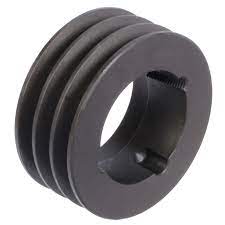
How do spa pulleys impact the overall performance and water quality in a spa?
Spa pulleys have a significant impact on the overall performance and water quality in a spa. Here’s a detailed explanation of how spa pulleys influence these aspects:
1. Water Circulation:
Spa pulleys play a critical role in facilitating water circulation within the spa system. The pulleys are connected to the pump impeller, which generates the necessary water flow. Efficient power transmission from the motor to the pump impeller ensures adequate water circulation throughout the spa. Proper water circulation helps maintain even water temperature, ensure uniform distribution of chemicals, and prevent the formation of stagnant areas where contaminants can accumulate.
2. Jet Performance:
The performance of spa jets, which provide hydrotherapy and massaging effects, is influenced by the pulleys. By controlling the speed and torque output of the pump impeller through the pulleys, the intensity and pressure of the jets can be adjusted. Properly sized and configured pulleys enable optimal jet performance, allowing users to customize the water pressure and flow rate to their preferences. This enhances the overall spa experience and ensures the effectiveness of hydrotherapy treatments.
3. Air Delivery:
In spas equipped with air blowers or air injectors, spa pulleys also impact the delivery of air. Air blowers or injectors are often driven by the motor through pulleys and belts or cables. The pulleys control the speed and power transmission, influencing the amount and intensity of air delivered to the spa. By adjusting the pulley size or ratio, the air delivery can be modified, affecting the aeration and bubbling effects in the spa. This contributes to the overall ambiance and relaxation experience for spa users.
4. Energy Efficiency:
Well-designed and properly maintained spa pulleys contribute to energy efficiency in the spa system. Efficient power transmission from the motor to the pump or other driven components minimizes power losses, reducing energy consumption. By ensuring the pulleys are correctly sized, aligned, and tensioned, unnecessary friction and wear can be minimized, resulting in smoother operation and improved energy efficiency. This not only reduces operating costs but also supports sustainable and eco-friendly spa practices.
5. Water Filtration:
Proper water filtration is crucial for maintaining water quality in a spa, and spa pulleys indirectly impact this process. The pump, driven by the pulleys, circulates water through the filtration system, removing debris, particles, and contaminants. Effective power transmission ensures sufficient water flow through the filter, optimizing its filtration capacity. Clean and properly functioning pulleys contribute to uninterrupted water filtration, preventing clogs or reduced filtration efficiency. This helps in maintaining clear and healthy spa water.
6. Overall System Reliability:
Reliable spa pulleys are essential for the overall performance and longevity of the spa system. Well-maintained pulleys minimize the risk of belt or cable slippage, misalignment, or premature wear. This enhances the reliability and durability of the pulley system, reducing the likelihood of breakdowns or interruptions in spa operation. A reliable pulley system ensures consistent performance, allowing spa owners to enjoy their spa with confidence.
In summary, spa pulleys have a significant impact on the overall performance and water quality in a spa. They influence water circulation, jet performance, air delivery, energy efficiency, water filtration, and the overall reliability of the spa system. By ensuring proper sizing, alignment, tensioning, and maintenance of the pulleys, spa owners can optimize the performance, enhance the spa experience, and promote clean and healthy spa water.

What types of belts or cables are typically employed with spa pulleys?
When it comes to spa pulleys, different types of belts or cables can be employed depending on the specific application and design of the system. Here’s a detailed explanation of the typical types of belts or cables that are commonly used with spa pulleys:
1. V-Belts:
V-belts are one of the most commonly employed types of belts with spa pulleys. They have a trapezoidal cross-section and are designed to fit into the grooves or notches present on the surface of the pulley. V-belts offer excellent grip and traction, allowing for efficient power transfer between the pulley and the driven component, such as the pump impeller or blower fan. They are flexible, durable, and suitable for moderate to high power transmission applications.
2. Timing Belts:
Timing belts, also known as synchronous belts, are toothed belts that feature teeth on the inner surface. These teeth fit into the corresponding grooves or teeth on the pulley’s surface, ensuring precise and synchronous power transmission. Timing belts are commonly used in applications that require accurate timing and positioning, such as controlling the rotation of the pump impeller or other components. They are known for their low noise, high efficiency, and resistance to slipping.
3. Flat Belts:
Flat belts, as the name suggests, have a flat surface and are typically made of materials like rubber or synthetic materials. Although less common in modern spa and hot tub systems, they may still be employed in certain applications. Flat belts are flexible, easy to install, and suitable for low power transmission requirements. However, they may have limitations in terms of grip and power transfer efficiency compared to V-belts or timing belts.
4. Cables:
In some spa and hot tub systems, particularly those with pulley-driven mechanical control systems, cables may be employed instead of belts. These cables are typically made of steel or other strong materials and are used to transmit linear motion or tension between the pulley and the component being controlled. For example, cables may be used to control the opening and closing of valves or the adjustment of water flow. The use of cables provides flexibility and precise control over the movement of components.
It’s important to note that the specific type of belt or cable employed with spa pulleys may depend on factors such as the manufacturer’s specifications, system design, load requirements, and intended application. Consulting the system’s documentation or contacting the manufacturer will provide accurate information on the recommended type of belt or cable to be used with a particular spa pulley.


editor by CX
2024-05-09
